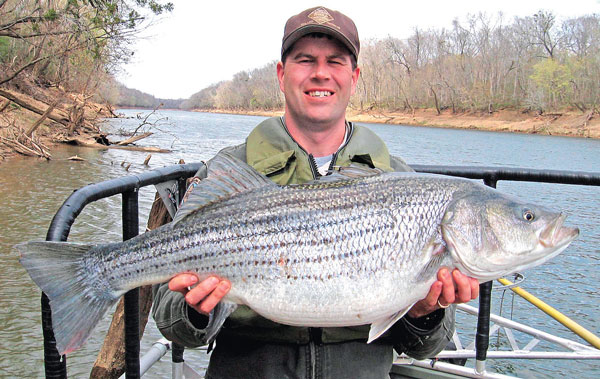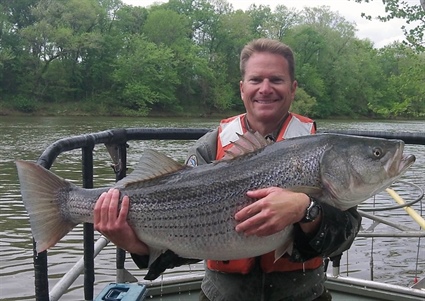By the NCFishes.com Team
North Carolina is home to 3 of the 6 species of Temperate Basses, plus one hybrid (Table 1) (Tracy et al. 2020). [Please note: Tracy et al. (2020) may be downloaded for free at: https://trace.tennessee.edu/sfcproceedings/vol1/iss60/1.] The 4th North American species of Morone, M. mississippiensis, Yellow Bass, is found primarily in the Midwest in the Mississippi River drainage. The two other species of Temperate Basses, European Seabass and Spotted Seabass, are known from the eastern Atlantic Ocean off the coast of Europe and Africa south to Senegal, the Mediterranean Sea, and the Black Sea (https://www.fishbase.in/identification/SpeciesList.php?genus=Dicentrarchus).
Table 1. Species of Temperate Basses found in North Carolina. Striped Bass Hybrid, Bodie Bass, and Palmetto Bass are not accepted common names by the American Fisheries Society (Page et al. 2013).| Scientific Name | American Fisheries Society Accepted Common Name |
|---|---|
| Morone americana | White Perch |
| Morone chrysops | White Bass |
| Morone saxatilis | Striped Bass |
| Morone saxatilis X Morone chrysops | “Striped Bass Hybrid, Bodie Bass, Palmetto Bass” |
Temperate Basses in North Carolina may be found primarily east of the Appalachian Mountains in our big rivers such as the Cape Fear, Yadkin, Catawba, Roanoke, Neuse, and Tar; in Piedmont reservoirs and the tail races below these dams; in natural lakes such as lakes Waccamaw and Mattamuskeet; and in the Albemarle and Pamlico sounds. [Note: see Supplemental Maps 1-3, page 14, showing North Carolina’s 100 counties, 21 river basins, and 4 physiographic regions.]
At first, we did not have a clue as to why the family Moronidae is called “Temperate Basses”. We thought, perhaps it was in reference to the family being found in waters where the climate is “moderate”, lacking extremes in temperature? However, Striped Bass is found off the chilly coast of Maine and the two other European species can be found ranging from the ice-cold waters of the North Sea to the warm tepid waters in the eastern Mediterranean Sea. Or perhaps it was in reference to the white flesh being mild, neither extreme nor excessive in flavor? The family Moronidae has always been commercially, recreationally, and culinarily important, often finding its way onto a dinner plate in a fancy East Coast restaurant or on the family kitchen table.
After coming up empty with other plausible reasons for its name, we then reached out to Chris Scharpf, one of the authors of the ETY Fish Project (http://www.etyfish.org/) to see if he could provide some clarification and/or debunk our theories. According to Christopher, in the Northern Hemisphere, “temperate” refers to areas between the Tropic of Cancer (the circle is currently 23.43655° north of the Equator (https://en.wikipedia.org/wiki/Tropic_of_Cancer) and the Arctic Circle. The zone to the south of the Arctic Circle is called the Northern Temperate Zone (https://en.wikipedia.org/wiki/Arctic_Circle). So this would include Maine. Chris further enlightened us by telling us that originally, “temperate basses” referred to the family Percichthyidae, which also included genera from Australia, Chile and Argentina. That family was split in the 1980s, with Morone going to Moronidae and retaining the name “temperate basses.” However, it was not until 2004 that the American Fisheries Society recognized the family Moronidae but opted for the common name “temperate basses” rather than the common name of “striped basses” as some workers have done. Percichthyidae is now called “temperate perches” (Nelson et al. 2004). So, I guess we were partially correct in our interpretation of the family’s common name derivation, but we still favor the culinary “hook”.
In North Carolina, rather than hearing them called Temperate Basses, you will hear them referred to as Waccamaws (perhaps because of White Perch’s abundance in Lake Waccamaw), silver perch (but not to be confused with the true Silver Perch, Bairdiella chrysoura, an estuarine and marine species), wiper, white lightning (the fish, not the hooch), rockfish (because of the Striped Bass’s spawning habits over shoals and rocky substrates or living among rocky ledges), blue-nosed perch, gray perch, stripe, striper, hybrids, and silver bass. Whatever they are called locally, the American Fisheries Society has officially accepted common names (Page et al. 2013) (Table 1) and each of their scientific (Latin) name actually means something (please refer to The Meanings of the Scientific Names of Temperate Basses, page 12).
Striped Bass (Figures 1 and 2) is one of our largest freshwater species, exceeded in length only by Atlantic Sturgeon, Acipenser oxyrhynchus. Maximum Total Lengths, reported by Rohde et al. (2009) for 3 of the 4 species are Striped Bass – 2000 mm (about 80 inches); White Bass – 450 mm (about 18 inches); and White Perch – 350 mm (about 14 inches). In 1585-1593, John White illustrated Striped Bass labeled with the Algonquin word used by the Croatoan First Peoples for Striped Bass, Mesickek (https://www.coastalcarolinaindians.com/updated-algonquian-word-list-by-scott-dawson/) and noted: “Some 5 or 6 foote in lengthe” (Figure 3).
Figure 1. Striped Bass. Photographs courtesy of the North Carolina Wildlife Resources Commission. Left – Kevin Dockendorf; Right – Chad Thomas.
Figure 2. Striped Bass. Photographs courtesy of the North Carolina Wildlife Resources Commission. Left – Jeremy McCargo; Right – Kirk Rundle.
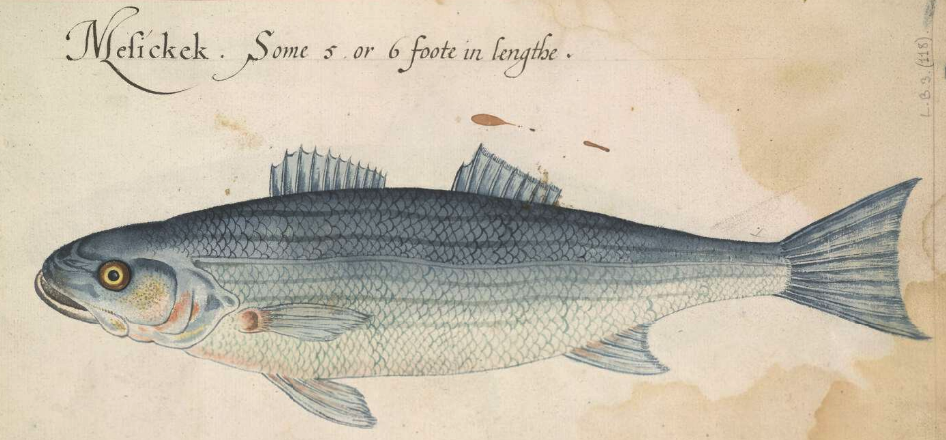
Figure 3. Painting of Striped Bass by John White, 1585-1593. Painting courtesy of the British Museum, Museum No. SL,5270.101 (https://www.britishmuseum.org/collection/object/P_SL-5270-101).
Reports of Striped Bass weighing more than 100 pounds in the late 1800s were noted by Smith (1907) and Jenkins and Burkhead (1994), but Striped Bass in North Carolina waters no longer reach that size, although they do get as heavy as 50+ pounds. Recent data also show that Striped Bass along the Atlantic Coast may live as long as 30+ years (McCargo 2020).
Historically, there were only two indigenous (native) species of Temperate Basses in North Carolina – Striped Bass and White Perch. More than a century after John White painted Striped Bass, both species were mentioned as occurring in North Carolina’s waters by John Lawson in 1709 who described the Striped Bass as: “They are a very good firm Fish. Their Heads are souced (i.e., soused or pickled) and make a noble Dish, if large” (Lawson (1709), p. 156). Although populations of Striped Bass along the Atlantic Coast have diminished over the past 300 years, both species are still found in Coastal Plain and nearshore coastal waters with the anadromous Striped Bass making late winter-early spring spawning runs up the larger rivers to the Fall Zone at the eastern edge of the Piedmont. Today, Striped Bass is found in all basins from the Catawba, where it has been introduced, eastward to the Atlantic Ocean, including the Lumber and Waccamaw River basins (Map 1). Land-locked populations, as a result of stockings, can be found in many of the larger reservoirs in the Hiwassee, Catawba, Yadkin, Cape Fear, and Roanoke basins (Tracy et al. 2020; NCWRC 2020a).
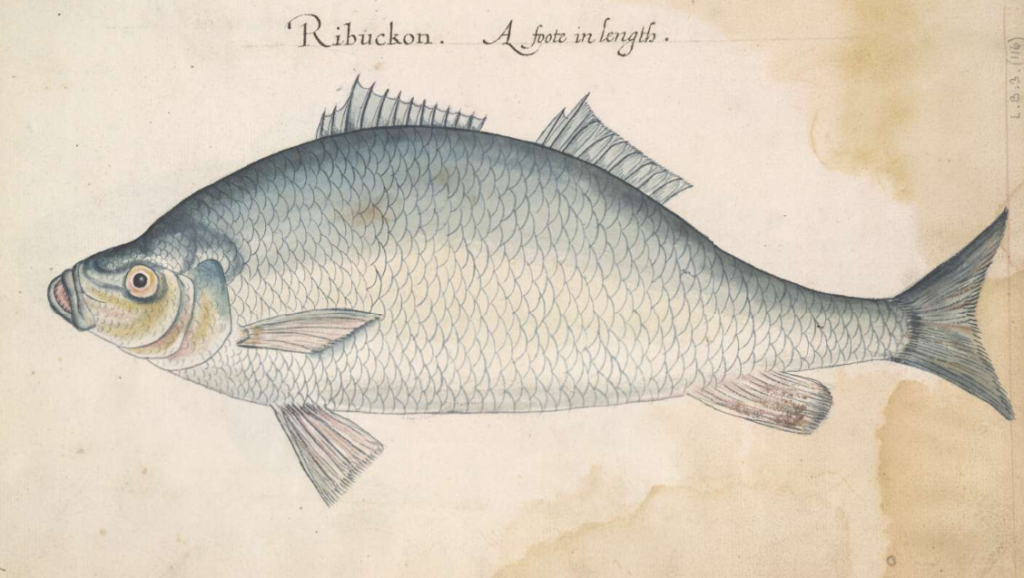
White Perch (Figure 4) make semi-anadromous spawning runs from brackish waters up the coastal rivers to fresh water, but not to the extent that Striped Bass do. Today, White Perch are abundant in reservoirs and rivers upstream from the Fall Zone where they are considered unauthorized bait-bucket introductions by anglers, whereas downstream, Coastal Plain populations are considered indigenous (Tracy et al. 2020). White Perch are now known from throughout the entire Catawba and Yadkin Chain-of-Lakes, from lakes Townsend, Cammack, and Shearon Harris in the Cape Fear basin, and in Kerr Reservoir in the Roanoke basin (Map 2).
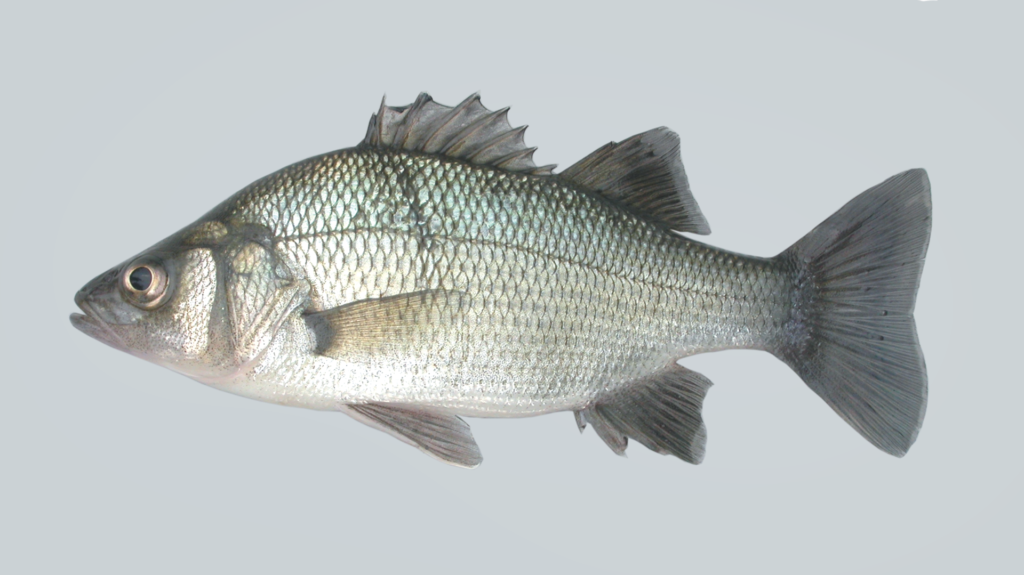
White Bass, a nonindigenous (non-native) species, was introduced into North Carolina waters as a new sportfish as early as the 1950s and today is found in our larger rivers and reservoirs from the Hiwassee to the Roanoke basin (Tracy et al. 2020) (Map 3).
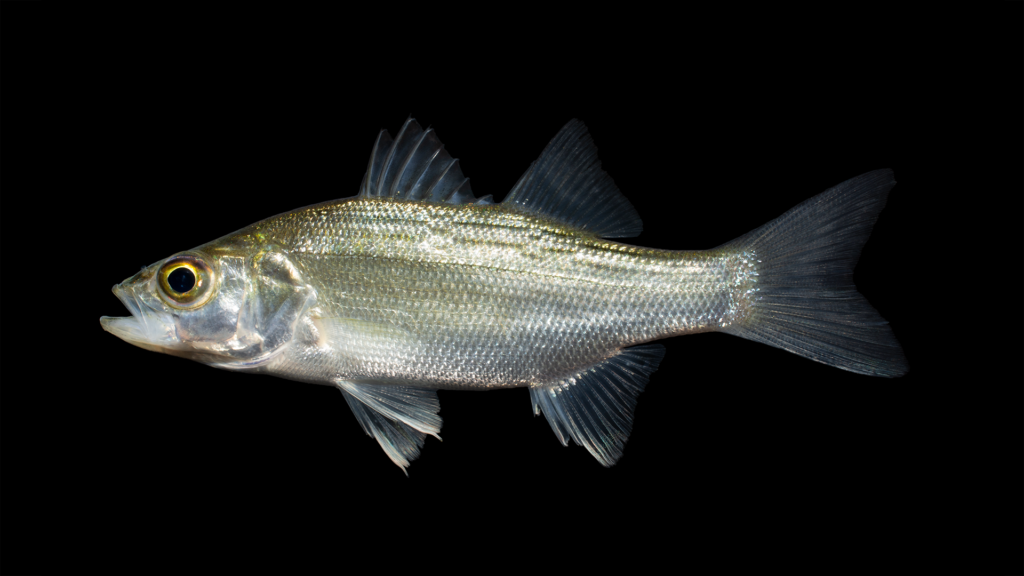
Striped Bass hybrid, also known as Bodie Bass or Palmetto Bass, is an aquaculture-created hybrid which did not occur naturally in North Carolina. These hybrids, first created in the mid-1960s, can be fertile and are known to back-cross with either parent in the wild (Hodson 1989). They are currently stocked by the North Carolina Wildlife Resources Commission in Hyco Reservoir (NCWRC 2019; https://hycolakemagazine.com/bodi-bass-introduced-into-hyco-lake/), Moss Lake, Oak Hollow Lake, Lake Townsend, Lake Thom-A-Lex, Salem Lake, W. Kerr Scott Reservoir, and Lake Norman (NCWRC 2010; NCWRC 2020a) and are also stocked privately in farm ponds. They also occur in Lake Chatuge and in the Albemarle and Pamlico sounds (NCWRC 2020b) and are known to occur in the Neuse River at Milburnie (Wake County) and in the Cape Fear River. There are only two vouchered specimens of Striped Bass hybrids at the North Carolina Museum of Natural Sciences, thus Map 4 does not give an accurate portrayal of their distribution.
Because all the species in the Family Moronidae are classified as well-sought after recreationally and commercially important game species, they are managed and regulated with seasonal and river-basin specific creel and landing limits by the North Carolina Wildlife Resources Commission and the North Carolina Division of Marine Fisheries (NCWRC 2020b; NCDMF 2020). Implementation of strict harvesting quotas, improved instream flows downstream of reservoirs, and more strict enforcement of water quality standards has helped the Striped Bass on its road to recovery. Although some Striped Bass populations continue to be severely depleted with poor recruitment, no species is listed as imperiled in North Carolina (NCAC 2017; NCNHP 2018; NCWRC 2017).
Key characteristics for their proper identification include the length and thickness of the 2nd and 3rd anal fin spines; the presence or absence and shape of a medial tooth patch on the tongue; the joining or separation of the two dorsal fins; body shape; and the intactness of the lateral striping along the sides (please refer to the Identification Key to the Species of Temperate Basses (Family Moronidae) in North Carolina).
If you have troubles with your identifications, just send us (https://ncfishes.com/contact/) an e-mail and include as many quality digital photographs as you can along with all the pertinent locality descriptors so that we will know from where the fish came. Additional information on our four species of Temperate Basses may be found at NCWRC (2010a-2010d).
